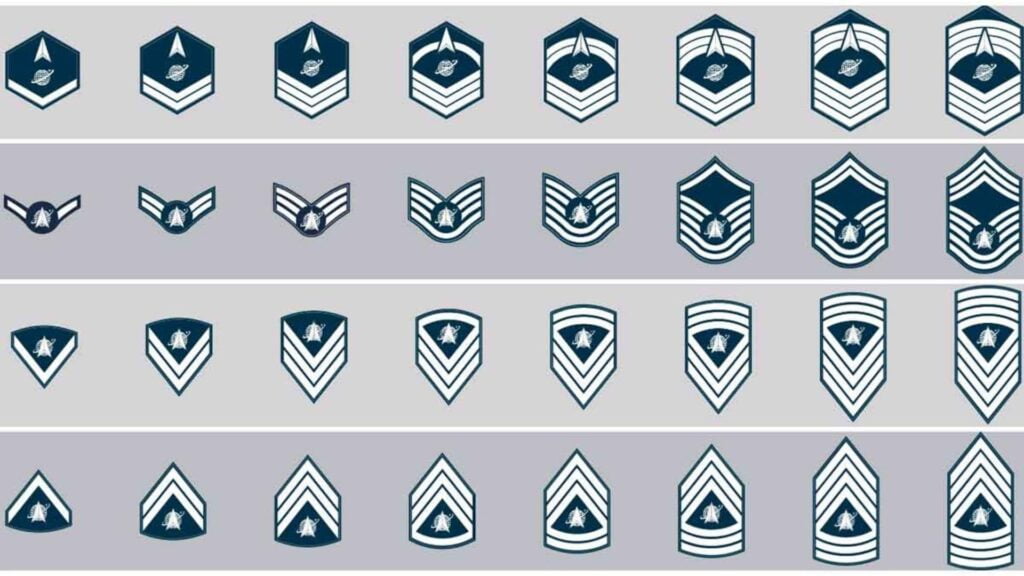Space Force Ranks

Rank is vital to how the US Space Force works on a day-to-day basis, in peacetime and wartime. The service is changing ranks for Guardians, replacing Air Force grades with new ones. The decision runs counter to the will of lawmakers like Rep. Dan Crenshaw and legends like William Shatner, who wanted the newest branch of the military to use naval ranks. The military’s newest branch has released its official rank structure for officers and enlisted members. The new ranks largely mirror those of the Air Force, with the exception of junior enlisted ranks. The Space Force will use specialist for E-1 through E-4 instead of Airman. This move is designed to allow the newest service to develop its own culture and identity, independent of its parent service.
The new rank names will take effect Feb. 1. Until then, enlisted Space Force Guardians will continue to wear Air Force rank insignia. The Space Force says it considered crowdsourced feedback when deciding on the rank names. The Space Force’s enlisted ranks will also see some changes, but not as significant as those for officers. In particular, junior enlisted guardians in the E-1 through E-4 ranks will be referred to as specialists rather than Airman. These personnel are responsible for basic training and specialized education in the field of space systems operations. In addition, as long as they maintain satisfactory performance and conduct, their promotion to E-2 is usually automatic.

Space Force Ranks Salary
The United States Space Force, the sixth military service branch, is recruiting and deploying forces to carry out global space operations. As a result, it is offering competitive salaries and benefits. This includes free health insurance and education. According to ZipRecruiter, the average annual salary for a Space Force job is $98,500. The best-paying jobs are located in Vallejo and Johnstonville, California.
The first rank in the USSF is specialist, which reflects a new recruit’s initial training and basic military skills. Specialists are eligible for promotion to E-2 after completion of basic training, provided they meet the service’s performance and conduct standards. At this point, promotions are typically automatic based on time in grade and years of service.
Once service members reach the specialist four rank, or E-4, they are considered to have adjusted to military life. This is when guardians are expected to perform their duties in a competent and professional manner, providing leadership and a positive example for others. They are also responsible for continuing to hone their professional abilities and develop a breadth of knowledge in the field of space system operations.

Space Force Rank Structure
The US Space Force has unveiled its rank structure for officers and enlisted personnel. With a few exceptions, the military’s newest service is sticking with a rank structure inherited from the Air Force. The sixth military branch had been debating the ranks it would use since its founding in 2019. Rep. Dan Crenshaw, a Texas Republican, and Star Trek actor William Shatner had advocated for the service to adopt Navy ranks.
Guardians in the E-4 ranks called noncommissioned officers (NCOs) in the Space Force, must work hard to hone their skills and gain experience. They are expected to set a good example for their subordinates and exhibit personal integrity, loyalty, leadership, and devotion to the mission. They are also expected to uphold the Space Force’s policies, traditions, and standards.
Once guardians reach the E-5 and E-6 ranks, they must compete for promotions. Their eligibility is determined by medals and awards, positive performance evaluations, specialty knowledge tests, promotion fitness exams, and time in grade/service. The most senior NCOs in the space force are master sergeant and senior master sergeant. Their rank insignia features chevrons that arc above the Globe and Orbit.
| Grade | Rank | Abbreviation | Terms of Address |
|---|---|---|---|
| E1 | Specialist 1 | Spc1 | Preferred term is Specialist but Spec1 or Specialist 1 are both acceptable |
| E2 | Specialist 2 | Spc2 | Preferred term is Specialist but Spec2 or Specialist 2 are both acceptable |
| E3 | Specialist 3 | Spc3 | Preferred term is Specialist but Spec3 or Specialist 3 are both acceptable |
| E4 | Specialist 4 | Spc4 | Preferred term is Specialist but Spec4 or Specialist 4 are both acceptable |
| E5 | Sergeant | Sgt | Sergeant |
| E6 | Technical Sergeant | TSgt | Sergeant or Technical Sergeant or Tech Sergeant |
| E7 | Master Sergeant | MSgt | Sergeant or Master Sergeant |
| E8 | Senior Master Sergeant | SMSgt | Senior or Senior Master Sergeant |
| E9 | Chief Master Sergeant | CMSgt | Chief or Chief Master Sergeant |
| E9 | Chief Master Sergeant of the Space Force | CMSSF | Chief or Chief Master Sergeant of the Space Force |
| O1 | Second Lieutenant | 2d Lt | Second Lieutenant or Lieutenant |
| O2 | First Lieutenant | 1st Lt | First Lieutenant or Lieutenant |
| O3 | Captain | Capt | Captain |
| O4 | Major | Maj | Major |
| O5 | Lieutenant Colonel | Lt Col | Lieutenant Colonel or Colonel |
| O6 | Colonel | Col | Colonel |
| O7 | Brigadier General | Brig Gen | Brigadier General or General |
| O8 | Major General | Maj Gen | Major General or General |
| O9 | Lieutenant General | Lt Gen | Lieutenant General or General |
| O10 | General | Gen | General |


